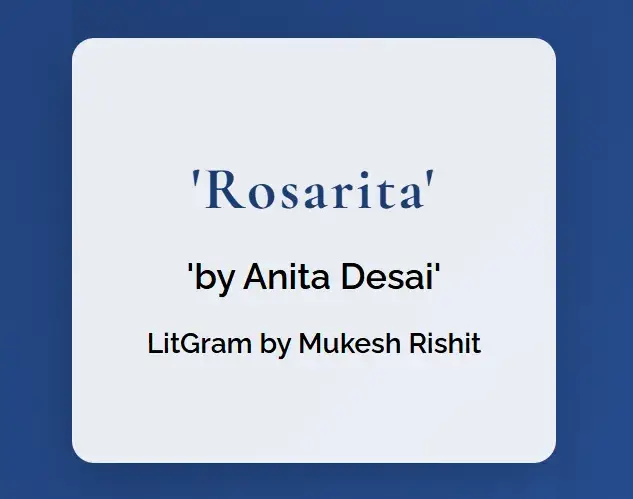Introduction
Some stories go beyond time and place to touch on shared human experiences. Anita Desai’s new novel, Rosarita, does just that. It mixes hazy memories with the search for who we are. Desai shows the complex bonds between mothers and daughters, with Indian and Mexican history as a backdrop. This blog post will look at the subtle details of this moving story, its complex characters, and its main ideas.
About Anita Desai
Brief Biography
Anita Desai, born in 1937 in Mussoorie India, has a major influence on Indian English literature. Her mixed background—with a German mother and a Bengali father—gives her a wealth of experiences to draw from in her writing. Desai’s books often look into questions of who we are feeling out of place, and what it means to be human, all wrapped up in her thoughtful writing style.
Literary Legacy
Desai’s impressive career features well-known novels like Fire on the Mountain, Clear Light of Day, Cry, the Peacock and In Custody. Her writing has earned her many awards, including three Booker Prize nominations and the Sahitya Akademi Award. In 2014, she received the Padma Bhushan, which further established her place in literature.
Setting the Context
Overview of the Release and Reception
Anita Desai’s Rosarita has been a awaited release signaling her comeback to novel-writing after ten years. The book has received good reviews, with critics praising it as an excellent example of literary editing and storytelling.
Socio-Cultural and Historical Context
Set in today’s world, Rosarita spans different places and cultures—from India to Mexico. The story’s two settings give Desai a chance to explore cultural clashes that drive the plot showing a complex historical background.
Plot Overview
Synopsis
Rosarita tells the story of Bonita, a young Indian woman who goes to San Miguel Mexico, to study language. Her normal life changes when she meets a stranger who claims Bonita looks like her mother Rosarita, who the stranger says was an artist in Mexico. Curious and confused, Bonita starts to uncover the truth about her mother’s history.
Major Plot Points
Bonita’s search takes her and the “Stranger”—later known as “Trickster”—across Mexico, including small villages and the coastal retreat of La Manzanilla. As she travels, Bonita remembers bits of her childhood, like a strange painting, invites to art talks, and a room full of her mother’s things. These hints lead her deeper into a tangle of possible facts and stories about her mother’s life.
Characters and Characterization
Introduction to Main Characters
The book centers on Bonita, a young Indian student whose life changes in Mexico. The “Stranger,” or “Trickster,” guides Bonita on her journey and plays a key part in the story.
Character Analysis: Bonita
Bonita struggles with her identity and her family’s history. Her story has moments that make us doubt, reflect, and discover, which helps us connect with her and find her story gripping.
Supporting Characters
The other people in the story, like Bonita’s family and the folks she meets in Mexico, add depth to the tale. They shine a light on the different cultural and personal battles she faces.
Themes and Motifs
Exploring Key Ideas
Rosarita explores themes like memory, grief, isolation, and a young woman’s resolve to chart her own course. The story focuses on Bonita’s journey to uncover her mother’s secret life highlighting her search and self-discovery.
Recurring Motifs
Symbols like mirrors, water, and paintings appear often in the story. They represent themes of reflection, change, and time’s passage.
Narrative Style and Techniques
Writing Style of Anita Desai
In Rosarita, Desai writes with a poetic yet clear style. She captures the nuances of human feelings and relationships. Her words paint vivid pictures pulling readers into her characters’ emotional and mental worlds.
Use of Literary Techniques
Desai uses several writing methods, like stream of consciousness, flashbacks, and vivid descriptions, to make her story more powerful. These methods pull readers into the main character’s world making her journey feel close and real.
Symbolism and Imagery
Key Symbols Used in the Story
Symbols like the sea traditional clothes, and family heirlooms play a big role in Rosarita. They stand for bigger ideas about freedom, who we are, and where we come from.
Desai’s Use of Visual and Sensory Imagery
Desai has a talent for painting vivid scenes that speak to the senses. Her descriptions bring to life the sounds of waves hitting the beach and the sights of old family treasures. Her imagery stands out and stirs the imagination.
Emotional and Psychological Depth
Looking at Emotions
The emotional richness of Rosarita makes it special. Desai digs deep into the main character’s thoughts and feelings. She captures the ups and downs of her inner life with great care.
Characters’ Mental States
Bonita’s mental journey has times of deep thought and discovery. Her changing relationships and views of herself give us a lot to think about. This makes the novel gripping to read.
Social and Cultural Commentary
Analysis of Social Issues
Rosarita deals with many social issues such as gender roles, family expectations, and cultural clashes. Through Bonita’s experiences, Desai offers a detailed critique of society’s norms and practices.
Cultural Nuances
The book is full of cultural details that show the complexities of modern Indian society. Desai uses rich descriptions and character interactions to paint a clear picture of the cultural scene.
Critical Reception
Early Reviews and Analysis
Initial reviews of Rosarita have been very positive. Critics praise its emotional depth and social relevance. They see the novel as proof of Desai’s lasting literary skill.
Fit within Desai’s Body of Work
Rosarita is a typical Desai novel reflecting the themes and writing style that define her larger body of work. It shows her talent for capturing the details of human life.
Comparative Analysis
Comparing with Previous Works
When you look at her earlier books, Rosarita has similar themes, like exploring identity and cultural conflicts, while bringing a new storytelling voice and viewpoint.
Parallels with Contemporary Authors
You can draw parallels between Rosarita and books by other current Indian writers such as Jhumpa Lahiri and Arundhati Roy, who also write about living between cultures and finding oneself.
Impact on Readers
Reader Responses and Interpretations
Rosarita has touched and inspired readers. The book’s emotional power and cultural depth stick with people leading them to think about their own lives and society.
Personal Reflection
I find Rosarita to be a touching look at the human spirit. It connected with me on a deep level showing me the layers of identity, culture, and finding oneself.
Legacy of Rosarita
Long-Term Influence on Literature
Rosarita is set to have a big effect on today’s literature in how it shows cultural and emotional struggles. It will stand out as a key part of Desai’s work.
Academic Studies and Literary Circles
Academics will study the novel because of its deep themes and complex storytelling methods. It will help people who want to explore modern Indian literature.
Conclusion
To sum up, Anita Desai’s Rosarita is more than a story; it takes a close look at identity cultural clashes, and deep emotions. Through Rosarita’s story, Desai encourages us to think about our own lives and society’s rules making this book just as important now as when people first looked forward to reading it. Whether you’ve loved Desai’s work for years or you’re new to her writing, Rosarita gives you a chance to see the skill of one of the best writers out there.
FAQs
- What is the main theme of Rosarita? The main theme of Rosarita revolves around identity and self-discovery, set against the backdrop of cultural and societal expectations.
- How does Anita Desai depict cultural conflicts in Rosarita? Desai depicts cultural conflicts through the protagonist’s interactions and the clashes between traditional values and modern aspirations.
- Who are the central characters in Rosarita? The central characters include Rosarita/Bolita, the protagonist, alongside her family members, friends, and the “Trickster.”
- What literary techniques are prominent in Rosarita? Prominent literary techniques in Rosarita include stream of consciousness, flashbacks, and rich imagery.
- Why is Rosarita significant in Anita Desai’s oeuvre? Rosarita is significant because it continues Desai’s tradition of exploring deep emotional and societal themes, adding a fresh perspective to her already impressive body of work.


